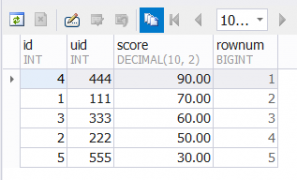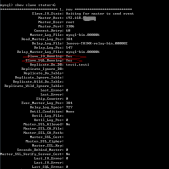1. 下载RPM安装包, 因为安装MySQL的时候,软件会需要一依赖关系, 所以建议把所有的安装包下载下载, 再依次安装所以的RPM包。
2. 在RedHat下安装后, root密码为空, 设置MySQL的 root密码, 用下面的命令来设置.
[nb@SIT ~]$ mysql -u root -p[newpassword]
3. 修改MySQL的root 密码, 用下面 的命令:
[nb@SIT ~]$ mysqladmin -u root -p[oldpasswrod] password[newpassword]
4. 用root登录MySQL, 输入下面的命令, 再输入密码, 就可以以root的身份登录到MySQL
[nb@SIT ~]$ mysql -u root -p
Enter password:
5. 出现下面的字符, 就表示成功登录到了MySQL,
Welcome to the MySQL monitor. Commands end with ; or \g.
Your MySQL connection id is 14
Server version: 5.5.14 MySQL Community Server (GPL)
Copyright (c) 2000, 2010, Oracle and/or its affiliates. All rights reserved.
Oracle is a registered trademark of Oracle Corporation and/or its
affiliates. Other names may be trademarks of their respective
owners.
Type 'help;' or '\h' for help. Type '\c' to clear the current input statement.
mysql>
6. 显示当前已经存在的数据库,输入: show databases;
mysql> show databases;
+--------------------+
| Database |
+--------------------+
| information_schema |
| mysql |
| performance_schema |
| test |
+--------------------+
4 rows in set (0.00 sec)
7. 创建一个新的数据库, 输入: create database [name];
mysql> create database mytest;
Query OK, 1 row affected (0.00 sec)
mysql> show databases;
+--------------------+
| Database |
+--------------------+
| information_schema |
| mysql |
| mytest |
| performance_schema |
| test |
+--------------------+
5 rows in set (0.00 sec)
8. 删除一个已经存在的数据库, 输入: drop database [name];
mysql> drop database mytest;
Query OK, 0 rows affected (0.00 sec)
mysql> show databases;
+--------------------+
| Database |
+--------------------+
| information_schema |
| mysql |
| performance_schema |
| test |
+--------------------+
4 rows in set (0.00 sec)
9. 创建一张表, 输入: create table [name] [option...]
显示表的内容: describe [table name];
mysql> create table device
-> (
-> id int,
-> pn varchar(8),
-> descript varchar(30)
-> );
Query OK, 0 rows affected (0.01 sec)
mysql> describe device;
+----------+-------------+------+-----+---------+-------+
| Field | Type | Null | Key | Default | Extra |
+----------+-------------+------+-----+---------+-------+
| id | int(11) | YES | | NULL | |
| pn | varchar(8) | YES | | NULL | |
| descript | varchar(30) | YES | | NULL | |
+----------+-------------+------+-----+---------+-------+
3 rows in set (0.00 sec)
10. 向表里面添加数据, 输入: insert into [table_name] set option1=[value], option2=[value] ...
mysql> insert into device set id=1,pn="abcd",descript="this is a good device";
Query OK, 1 row affected (0.01 sec)
mysql> insert into device set id=2,pn="efgh",descript="this is a good device";
Query OK, 1 row affected (0.00 sec)
11. 查看表里面的内容, 输入: select [col_name] from [table_name]
mysql> select * from device;
+------+------+-----------------------+
| id | pn | descript |
+------+------+-----------------------+
| 1 | abcd | this is a good device |
| 2 | efgh | this is a good device |
+------+------+-----------------------+
2 rows in set (0.01 sec)
12. 选择性的查询表里的内容, * 是通配符, 表示所有的, 查询单项的时候, 输入: select * from [table_name] where opiont=[value];
mysql> select * from device where id=2;
+------+------+-----------------------+
| id | pn | descript |
+------+------+-----------------------+
| 2 | efgh | this is a good device |
+------+------+-----------------------+
1 row in set (0.00 sec)
13. 选择性查询表里的内容, 输入: select [option]...[option] from [table_name] where [option]=[value];
mysql> select id,descript from device where id=2;
+------+-----------------------+
| id | descript |
+------+-----------------------+
| 2 | this is a good device |
+------+-----------------------+
1 row in set (0.00 sec)
RedHat下MySQL的基本使用方法分享
2019-11-22 14:34MYSQL教程网 Mysql
RedHat 下MySQL安装,简单设置以用基本的使用方法,需要的朋友可以参考下。
延伸 · 阅读
- 2019-11-22mysql千万级数据大表该如何优化?
- 2019-11-22PHP导入Excel到MySQL的方法
- 2019-11-22在php和MySql中计算时间差的方法
- 2019-11-21oracle与mysql的视频教程下载地址分享
- 2019-11-21linux忘记mysql密码处理方法
- 2019-11-21解决mysql ERROR 1017:Can't find file: '/xxx.frm' 错误
精彩推荐
- Mysql

网上提供的最简便的MySql数据库备份的方法
使用MYSQL进行 数据库备份 ,又很正规的数据库备份方法,同其他的数据库服务器有相同的概念,但有没有想过,MySQL会有更简捷的使用文件目录的备份方法...
- Mysql

java实现插入mysql二进制文件,blob类型,遇到问题及解决办法
mysql插入二进制文件,blob类型,遇到问题及解决办法 ...
- Mysql

Mysql my.ini 配置文件详解
Mysql my.ini 配置文件详解 ...
- Mysql

MYSQL实现排名及查询指定用户排名功能(并列排名功能)实例代
这篇文章主要给大家介绍了关于MYSQL实现排名及查询指定用户排名功能(并列排名功能)的相关资料,文中通过示例代码介绍的非常详细,对大家的学习或...
- Mysql

MySQL 分表优化试验代码
我们的项目中有好多不等于的情况。今天写这篇文章简单的分析一下怎么个优化法。 ...
- Mysql

linux下备份MYSQL数据库的方法
这是一个众所周知的事实,对你运行中的网站的MySQL数据库备份是极为重要的。 ...
- Mysql

CentOS 7 下使用yum安装MySQL5.7.20 最简单方法
这篇文章主要介绍了CentOS 7 下使用yum安装MySQL5.7.20 最简单 方法,需要的朋友可以参考下...
- Mysql

Mysql主从数据库(Master/Slave)同步配置与常见错误
今天小编就为大家分享一篇关于Mysql主从数据库(Master/Slave)同步配置与常见错误,小编觉得内容挺不错的,现在分享给大家,具有很好的参考价值,需要的朋...










